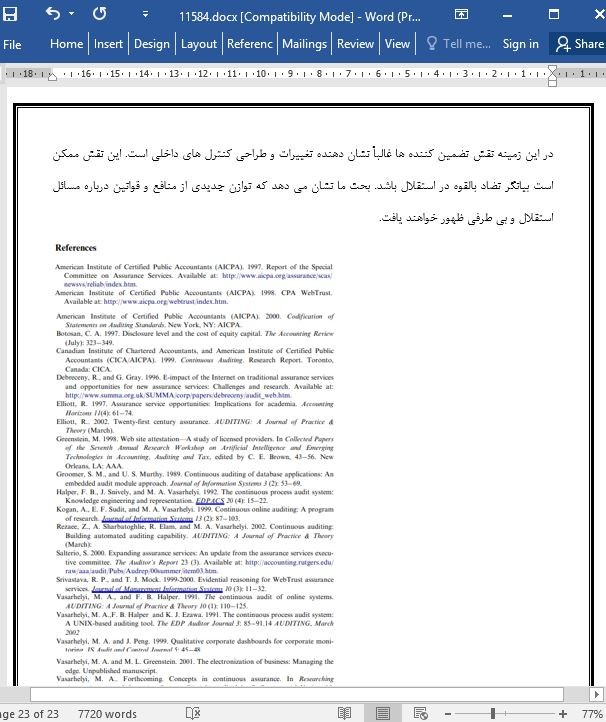
امکان پذیری و اقتصاد تضمین مستمر
چکیده
با عنایت به توجه فزاینده به مبحث مزبور، هم به صورت کاربردی و هم دانشگاهی، بررسی مفهوم تضمین مستمر (CA) و مسیرهای محتملی که در راستای آن، چنین خدماتی تکامل می یابند، اقدامی بهنگام و حائز اهمیت می باشد. بررسی CA صرفاً از نقطه نظر توانمندسازهای فناوری مورد توجه می باشد. بدین ترتیب قابل تصور خواهد بود که CA به عنوان یک مبحث درسی تلقی گردد. آنچه که کمتر بدان پرداخته شده، معماری کسب و کار است که زیربنای CA شمرده می شود. به طور خاص ما نشان می دهیم که محرک کلیدی CA، تقاضا نسبت به آن می باشد. در حالی که ممکن است معاملات اقتصادی بسیاری بین شرکت و سهامداران وجود داشته باشد که از تمهیدات CA بهره مند می گردد؛ هیچ تضمینی وجود ندارد که CA مقرون به صرفه - تنها راه افزایش کارآیی - و یا به واقع مستمر باشد. سایر عوامل موثر بر توسعه CA عبارتند از نیاز به زیرساخت های جدید برای پرداخت آن و نیز مسائل مربوط به استقلال تضمین کنندگان. هم چنین ما به شناسایی برخی از موضوعات تحقیق مهم پرداختیم.
مقدمه
با توجه به شتاب جریان اطلاعات و دسترسی به سیستم های بیدرنگ و آنلاین سازمانی، حرفه حسابداری درباره معنای حسابرسی و نحوه انجام آن بازنگری نموده است. اینک باور عمومی بر آن است که "حسابرسی آرشیوی" که در طی آن حسابرس در پایان سال وارد شده، صورتحساب ها را بررسی نموده و به اظهار نظرهای واقعی می پردازد که اگر عوض نگردد لاجرم با یک کارکرد بموقع تر و نزدیک به واقعه و نیمه نظارتی تکمیل می گردد که در طی آن تضمین کنندگان مستقل با شرکت ها و ذینفعان شخص ثالث برای ارائه فرم های جدیدی از محصولات تضمین همکاری می نمایند (کینی، 1999؛ الیوت 1997؛ واسارهلی، در شرف ارائه).
نتيجه گيری
غالب توجهات و بحث ها درباره تضمین مستمر (CA) تاکنون به جنبه های فناوری پرداخته شده و معماری اقتصادی را می پذیرند که زمینه ساز همه تضمین ها هستند. ما احساس می کنیم که نیازهای با وزن برابر در تقاضا برای محصولات تضمین مستمر و زیرساخت های لازم اقتصادی برای تولید و پرداخت هزینه CA مستقر شده اند.
Summary
Given the growing interest in the topic, both in practice and academia, it is timely and important to examine the concept of continuous assurance (CA) and the possible paths along which such services will evolve. There has been a tendency to see CA purely from the point of view of its technological enablers. As such, it has virtually been taken for granted that CA will follow as a matter of course. What has been less thought through is the business architecture that must underlie CA. In particular, we show that the key driver of CA is the demand for it. While there may be many economic transactions between the company and its stakeholders that could benefit from the provision of CA, there is no guarantee that CA is either cost effective—the only way of enhancing efficiency—or actually has to be continuous. Other factors that will affect the development of CA are the need for a new infrastructure to pay for it, as well as concerns about the independence of the assurors. We also identify some important research issues.
Introduction
With the acceleration of information flows and the availability of online real-time enterprise systems, the accounting profession has started to reconsider what an audit means and how it is carried out. It is now widely believed that the “archival audit” where the auditor comes in at the end of the year, examines statements, and issues ex post opinions will inevitably be supplemented, if not replaced, by a more timely, close-to-the-event semi-supervisory function, where independent assurors will work with both third-party stakeholders and firms to provide new forms of assurance products (Kinney 1999; Elliot 1997; Vasarhelyi forthcoming).
Conclusion
Most of the attention and discussion of continuous assurance (CA) thus far has been paid on the technological aspects, taking for granted the economic architecture that underlies all assurance. We feel that equal weight needs to be placed on the demand for continuous assurance products and the economic infrastructure necessary to produce and pay for CA.
چکیده
مقدمه
تجزیه و تحلیل تضمین مستمر در یک محیط ASP
اجزای ضروری تضمین
اجزای تضمین
ثبت مستمر معاملات کسب و کار
نظارت، تضمین و گزارشگری معاملات
تقاضای برای تضمین مستمر
تقاضای ذاتی برای تضمین
آیا تقاضا برای تضمین ضمانت شده است؟
تقاضا برای تضمین بیدرنگ
پرداخت هزینه تضمین مستمر
نیاز به زیرساخت های پرداخت هزینه تضمین
هزینه های ارائه تضمین
مالکیت محصولات تضمین
استقلال تضمین کننده و معماری فنی تضمین مستمر
موضوعاتی برای تحقیق بیشتر
نتيجه گيری
Summary
Introduction
Analysis of Continuous Assurance in an ASP Setting
Essential Components of Assurance Components of Assurance
Continuous Recording of Business Transactions
Transaction Monitoring, Assurance, and Reporting
Demand for Continuous Assurance
Inherent Demand for Assurance
Is Demand for Assurance Guaranteed?
Demand for Real-Time Assurance
Paying for Continuous Assurance
Need for a Payment Infrastructure for Assurance
Costs of Providing Assurance
Ownership of Assurance Products
Assuror’s Independence and the Technical Architecture of Continuous Assurance
Issues for Further Research
Conclusion
- اصل مقاله انگلیسی با فرمت ورد (word) با قابلیت ویرایش
- ترجمه فارسی مقاله با فرمت ورد (word) با قابلیت ویرایش، بدون آرم سایت ای ترجمه
- ترجمه فارسی مقاله با فرمت pdf، بدون آرم سایت ای ترجمه


